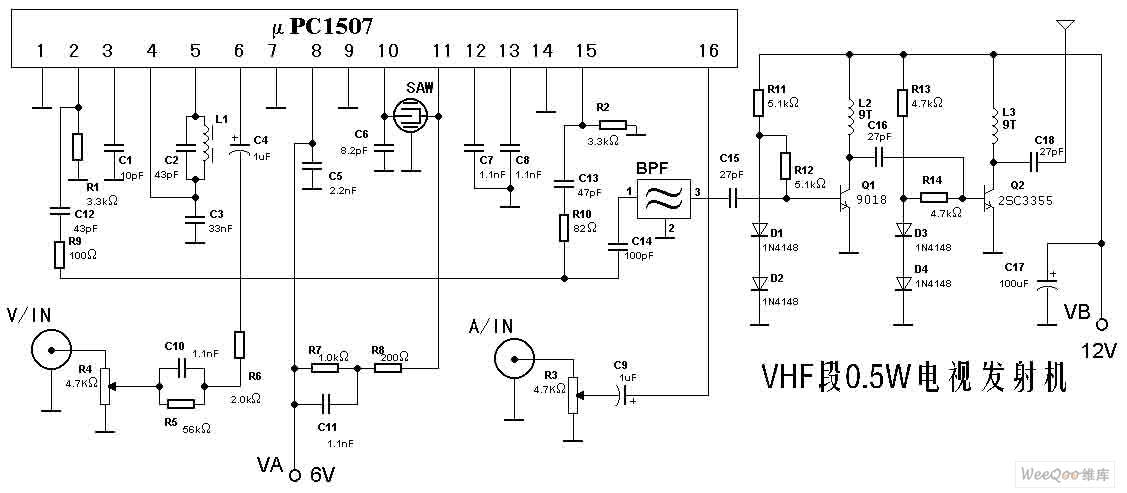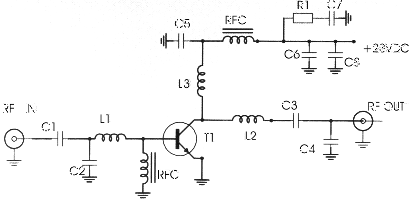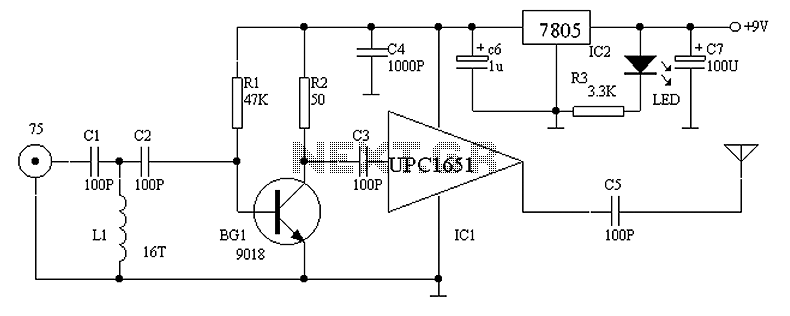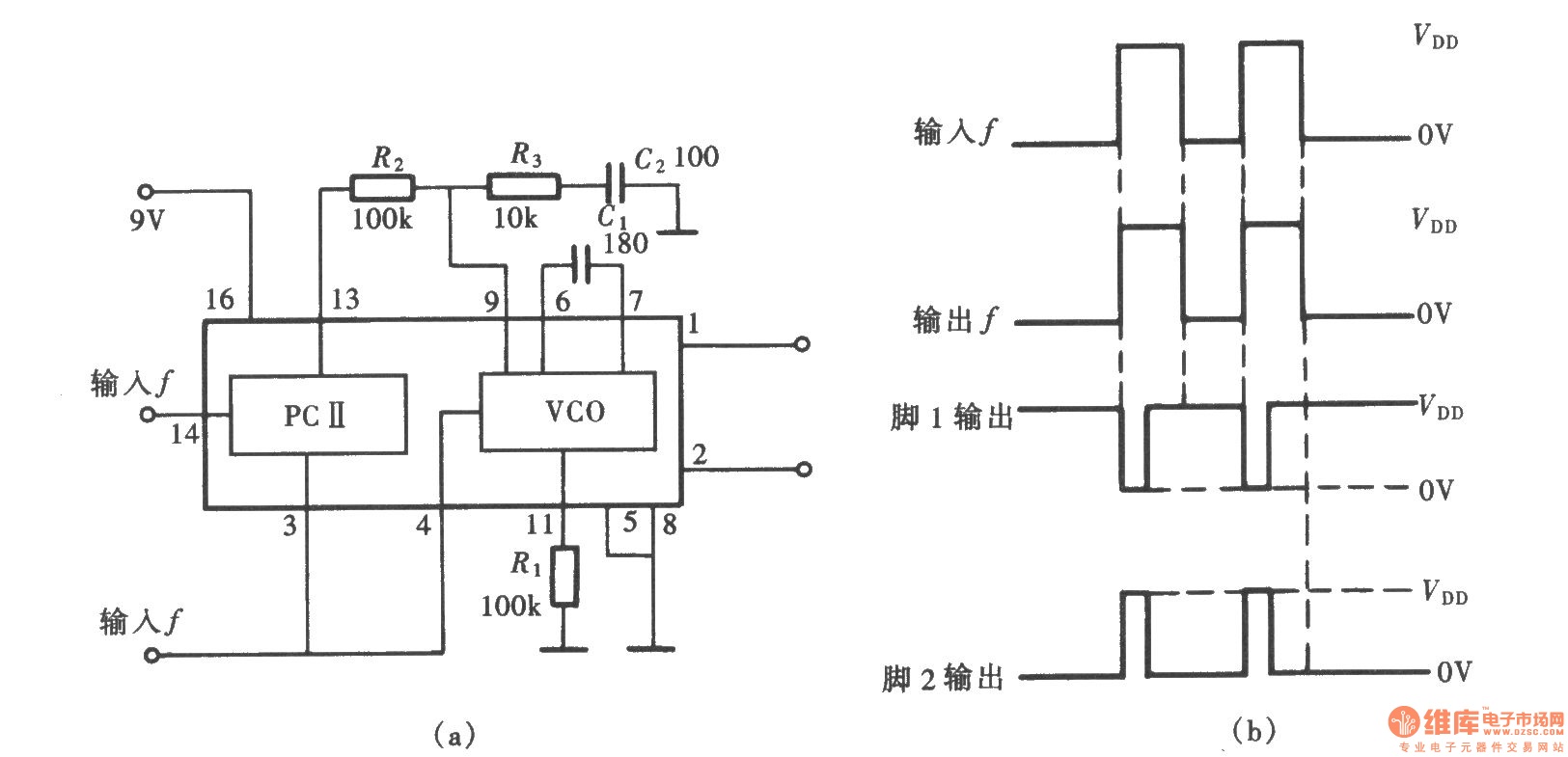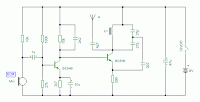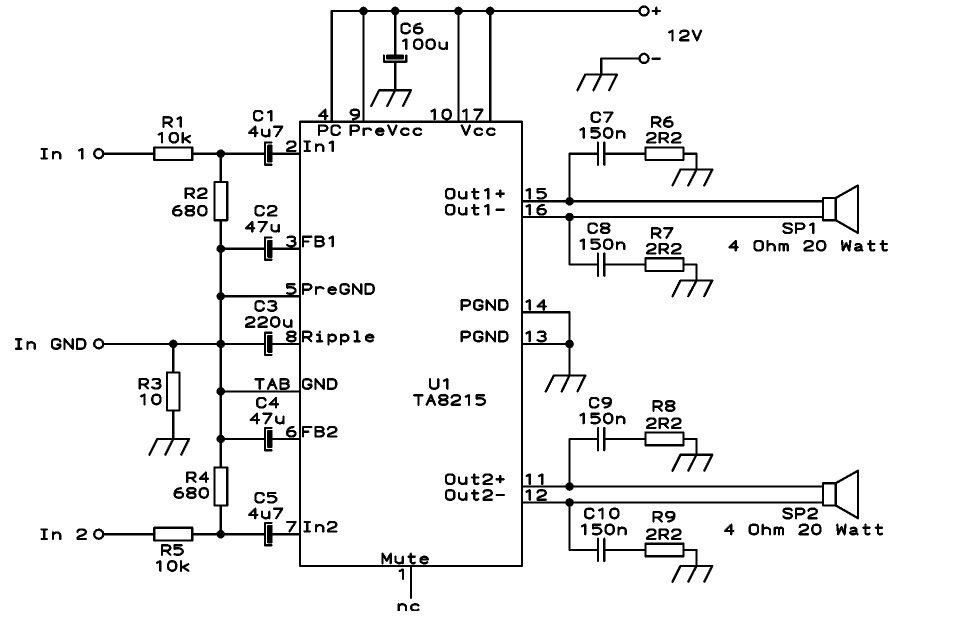
stereo pll fm transmitter based bh1417
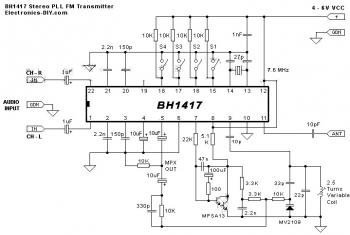
The circuit diagram of a stereo PLL FM transmitter based on the BH1417 chip is presented. This recent design from RHOM integrates numerous capabilities within a compact package. It features pre-emphasis and a limiter to maintain consistent audio levels during transmission, a stereo encoder for stereo transmission, and a low-pass filter that eliminates any audio signals above 15 kHz to prevent RF interference. The PLL circuit ensures stable frequency transmission with minimal drift, while the FM oscillator and RF output buffer facilitate effective signal output. The transmitter offers 14 selectable transmission frequencies in 200 kHz increments, ranging from 88.7 to 89.9 MHz for the lower band and from 107.7 to 108.9 MHz for the upper band, adjustable via a 4-DIP switch. The BH1417 operates on a supply voltage of 4 to 6 volts and consumes approximately 30 mA, providing an output RF power of 20 mW. The chip achieves a channel separation of 40 dB, which is commendable, though the older BA1404 FM transmitter chip offers slightly better separation at 45 dB. The BH1417 is available only in an SOP22 IC package, which may pose a limitation for some users. However, its smaller size compared to traditional DIP-based ICs allows for the entire transmitter to be accommodated on a compact PCB. The BH1417 can also function as a standalone stereo encoder, providing flexibility in working with various transmitters and amplifiers. Essential components such as pre-emphasis, limiter, stereo encoder, and low-pass filter are integrated into this compact design, requiring very few external components. The MPX output at PIN 5 can be directly connected to an external FM transmitter through a 10 µF capacitor. For detailed information about this circuit, a kit for the stereo PLL FM transmitter based on the BH1417 is also available.
To create a PCB for this transmitter, utilize PCB design software like Eagle. Print the design on photo or glossy paper using a laser printer. Adhere the printed design to the copper side of the PCB and apply heat with a hot iron plate, allowing the ink to transfer onto the PCB, which will then be ready for the etching process. If a laser printer is unavailable, the design can be printed on standard paper and copied onto glossy paper at a local copy service.The circuit diagram of stereo PLL FM transmitter based BH1417 chip. This is certainly the most recent BH1417 FM Transmitter design diagram from RHOM that consists of lots of capabilities in a single tiny package. It includes pre-emphasis, limiter to ensure that the music can be transmitted at the same audio level, stereo encoder for stereo tr
ansmission, low pass filter that blocks any audio signals above 15KHz to avoid any RF interference, PLL circuit that delivers rock solid frequency transmission (no extra frequency drift), FM oscillator and RF output buffer. There is certainly 14 possible transmission frequencies with 200KHz increments that you can select using a 4-DIP switch.
Lower band frequencies begin from 88. 7 up to 89. 9 MHz, and upper band frequencies begin from 107. 7 up to 108. 9 MHz. BH1417 could be supplied with 4 - 6 voltage and needs only about 30mA, giving 20mW output RF power. BH1417 delivers 40dB channel separation that is fairly good, although older BA1404 FM Transmitter chip delivers slightly better 45dB channel separation. BH1417 is only offered in SOP22 IC case so this may possibly be an inconvenience for some people. On the other hand, since the chip is smaller than common DIP-based ICs it`s possible to fit the whole transmitter on a compact PCB.
BH1417 chip may possibly also be applied a stand alone stereo encoder. The benefit of that`s that you have full freedom of working with a transmitter and amplifier of your choice. You will still have a pre-emphasis, limiter, stereo encoder and low pass filter in a single tiny package since very few external components are required for these blocks.
PIN 5 is MPX output that could be directly connected to an external FM transmitter through a 10uF capacitor. Detailed information about this circuit, visit:. The kit of stereo PLL FM transmitter based BH1417 also available there. Make a PCB in very easy steps. ! Create your PCB design using PCB designer software like Eagle, print out your design on photo paper or glossy paper with laserjet printer.
Stick the printed design on the PCB (copper side) and then heat it using hot iron plate. The ink will stick on the PCB and it will be ready for etching process. Note: If you don`t have laserjet printer, then you can print the design on standard paper. Copy the printed design at Copy Service around your location (with glossy paper). 🔗 External reference
To create a PCB for this transmitter, utilize PCB design software like Eagle. Print the design on photo or glossy paper using a laser printer. Adhere the printed design to the copper side of the PCB and apply heat with a hot iron plate, allowing the ink to transfer onto the PCB, which will then be ready for the etching process. If a laser printer is unavailable, the design can be printed on standard paper and copied onto glossy paper at a local copy service.The circuit diagram of stereo PLL FM transmitter based BH1417 chip. This is certainly the most recent BH1417 FM Transmitter design diagram from RHOM that consists of lots of capabilities in a single tiny package. It includes pre-emphasis, limiter to ensure that the music can be transmitted at the same audio level, stereo encoder for stereo tr
ansmission, low pass filter that blocks any audio signals above 15KHz to avoid any RF interference, PLL circuit that delivers rock solid frequency transmission (no extra frequency drift), FM oscillator and RF output buffer. There is certainly 14 possible transmission frequencies with 200KHz increments that you can select using a 4-DIP switch.
Lower band frequencies begin from 88. 7 up to 89. 9 MHz, and upper band frequencies begin from 107. 7 up to 108. 9 MHz. BH1417 could be supplied with 4 - 6 voltage and needs only about 30mA, giving 20mW output RF power. BH1417 delivers 40dB channel separation that is fairly good, although older BA1404 FM Transmitter chip delivers slightly better 45dB channel separation. BH1417 is only offered in SOP22 IC case so this may possibly be an inconvenience for some people. On the other hand, since the chip is smaller than common DIP-based ICs it`s possible to fit the whole transmitter on a compact PCB.
BH1417 chip may possibly also be applied a stand alone stereo encoder. The benefit of that`s that you have full freedom of working with a transmitter and amplifier of your choice. You will still have a pre-emphasis, limiter, stereo encoder and low pass filter in a single tiny package since very few external components are required for these blocks.
PIN 5 is MPX output that could be directly connected to an external FM transmitter through a 10uF capacitor. Detailed information about this circuit, visit:. The kit of stereo PLL FM transmitter based BH1417 also available there. Make a PCB in very easy steps. ! Create your PCB design using PCB designer software like Eagle, print out your design on photo paper or glossy paper with laserjet printer.
Stick the printed design on the PCB (copper side) and then heat it using hot iron plate. The ink will stick on the PCB and it will be ready for etching process. Note: If you don`t have laserjet printer, then you can print the design on standard paper. Copy the printed design at Copy Service around your location (with glossy paper). 🔗 External reference
